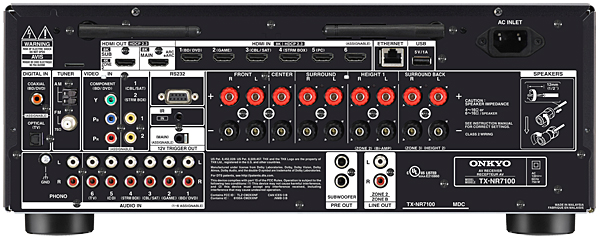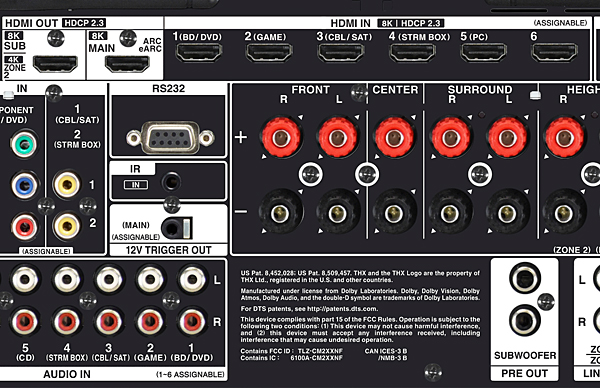Onkyo TX-NR7100 9.2-Channel A/V Receiver Review

AT A GLANCE
Plus
Onboard Dirac Live room/speaker correction
Nine amp channels for a full Atmos/DTS:X experience
Multiple HDMI 2.1 connections with 8K/60Hz and 4K/120Hz support
Minus
Small remote control a bit cramped
Somewhat light-duty casing and speaker outputs
THE VERDICT
This affordable Onkyo AVR renders powerful Dolby Atmos and DTS:X sound via its nine built-in amp channels, and it brings the considerable benefits of Dirac Live room EQ as well.
The arrival of yet another A/V receiver doesn't usually engender much excitement here at S&V's currently sub-arctic regional headquarters in New England. But Onkyo's new TX-NR7100 is not "just another" receiver. First, the TX-NR7100 features a true nine-channel-power layout, which makes possible a full 5.1.4 Dolby Atmos system without supplemental amplification within hollerin' distance of the magical ten-Benjamins line. Just as notably, it's among the first affordably priced AVRs to incorporate Dirac Live, the eponymous Swedish tech firm's widely praised room/speaker-correction software system, at no extra cost.
Otherwise, being a typical A/V receiver, the TX-NR7100 incorporates more features than Jimmy and Rosalynn have peanuts. Let's start with the most confusing one, HDMI connections. Onkyo states version 2.1 status for all the receiver's six main HDMI inputs but only the first three inputs (and two outputs) provide 40Gbps bandwidth, while the others max out at 24Gbps. Otherwise, the TX-NR7100's list of HDMI features include: VRR (Variable Refresh Rate, ALLM (Auto Low Latency Mode), QFT (Quick Frame Transport), DSC (Display Stream Compression), QMS (Quick Media Switching), and eARC (on the main HDMI output). As for high dynamic range pass-through, HDR10+, Dolby Vision, HDR10, and HLG are supported. One of the TX-NR7100's HDMI output stands ready to serve a second, remote zone output, but in that instance video support tops out at 4K/60Hz.
Chromecast built-in and AirPlay2 wireless streaming are onboard, as is two-way Bluetooth including Bluetooth aptX HD on the transmit side. With nine amp channels, there are multiple zone 2/3 options, including a clever one that sends the main-zone stereo audio to a pair of "Zone B" line-out jacks, typically used to drive a transmitter for wireless headphones or speakers. There's lots more, of course, but for most of the rest you'll need to geek out on Onkyo's website.
Setup
Onkyo has not changed its physical receiver layout in forever, which means the TX-NR7100 hews to the classic, three-knob-plus-buttons formula. However, the company has killed the drop-down door and million tiny keys for secondary features, leaving these mostly to the onscreen menus and remote control, making the front panel a good deal more spacious.

Unboxing and wiring up the new Onkyo entailed no surprises, though I am bound to observe that the rather light-gauge (and somewhat boingy) top/side-cover sheetmetal did not thrill me. Nor did the palpably light-duty, for an over-$1,000 receiver, speaker connectors, the type that are not spaced for dual-bananas. This made setup (mine, anyway) a little fussier. Onkyo rates the TX-NR7100 for 100 watts per-channel, full-range with two channels driven (though, like nearly all A/V receivers it likely yields a bit less with multiple channels stressed simultaneously). Onkyo's spec sheet refers to "Select Dynamic Audio Amplification," which we were able to confirm with Onkyo is actually class-A/B).
Onkyo's onscreen initial-setup routine uses mostly just plain and readable text and is reliably clear, succinct, and un-confusing. Response times could have been sprightlier—switching from source to setup-menu and back took about 3 seconds either way.

I connected my 5.1.4-channel Atmos/DTS:X layout, a mongrel but very effective collection of loudspeakers including ceiling-bounce front and high-mounted rear heights and proceeded to the main event: room/speaker EQ. Unique in my experience, the TX-NR7100 offers two options: Dirac Live (which gets ordinal preference in the initial-setup routine), and Onkyo's own proprietary AccuEQ. Naturally, I chose Dirac for my first run.
Into the Dirac Dimension
Dirac is a Swedish firm that arose from an acoustical/DSP research group at Uppsala University in almost precisely the same way in which Audyssey, which effectively initiated the mass room/speaker-calibration movement in home audio, grew, a bit earlier, from a similar lab at USC. Unlike most competing acoustical calibration systems, Dirac Live is not wholly on board the host; you need an outboard device to run its software. In the Onkyo's case, this will be a tablet or phone running the firm's new Onkyo Controller iOS/Android app, which has the Dirac Live access baked in.
I used this to perform Dirac's "Detailed" setup, which averages 9 microphone positions; for a full 5.1.4-channel layout the whole routine took about 45 minutes. The "Quick" option uses just three mic positions. (Another note: the Onkyo implementation does not include the standalone Dirac Live Bass Control feature, which can integrate multiple subwoofers.) The results were in line with what I've come to expect from many runs of Audyssey, Dirac, and other-label robo-EQ routines. It correctly obtained my 9-speaker-plus-sub layout (it queries the receiver for this, which you will have previously established via the setup menu), set levels and distances (delays) correctly, and dialed in equalization "cuts" for my room's two most egregious modes, at about 85Hz and 135Hz. It also set EQ to correct the much smaller deviations elsewhere in each speaker's response and imposed an overall default "house curve" that's embedded in the Dirac Live software. This down-tilts by about 1.5 dB per octave from around 200 Hz on up and is consistent with currently accepted research and best practices that demonstrate that literally flat octave-to-octave reproduction will sound unnaturally bright.
The routine loads the same results in triplicate into all three of the TX-NR7100's EQ memories. Working within the app, you can subsequently modify one (or more) of these to your own preferences by pulling little on-screen "handles" up or down (boost/cut) or laterally (frequency; "Q") along a frequency graph. This is powerful stuff that will enable a knowledgeable user to fine-tune the corrections—or a reckless one to cause untold sonic mayhem, which is why I believe Audyssey, at least initially, did not provide similar capabilities.
I subsequently ran Onkyo's own AccuEQ routine, which produced results that were generally similar, by ear, though not identical. As far as I could tell, at least, since there's no way to view AccuEQ's results graphically. Also, A-B listening comparisons between Dirac and AccuEQ were wholly impracticable since you can't store both a Dirac and an AccuEQ "run" in the receiver's memories simultaneously. What's more, a re-test-and-load of either boots whatever previous EQs were stored out in the ether, though the Onkyo Controller app does store either your latest Dirac or AccuEQ "run," enabling the manual tweaking and re-loading of EQ data from the app into the receiver.
In addition to the iOS/Android app, you can calibrate the TX-NR7100 using the standalone Dirac Live application running on a Mac or PC plus a suitable calibrated measurement mic, which likely delivers more detail and more memory/storage options. Regrettably, the current release requires a newer version of the MacOS than my somewhat aged iMac can run.
Performance
I performed a few runs of both Dirac and AccuEQ as I found my way around, as I imagine most users will do. Dirac in particular is rather fussy about levels and, annoyingly, restarts the entire measurement routine when it finds a channel above or below optimal volume, so make a fresh pot of coffee before you begin.






























































